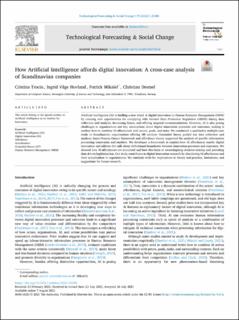| dc.contributor.author | Trocin, Cristina | |
| dc.contributor.author | Hovland, Ingrid Våge | |
| dc.contributor.author | Mikalef, Patrick | |
| dc.contributor.author | Dremel, Christian | |
| dc.date.accessioned | 2022-10-12T05:45:16Z | |
| dc.date.available | 2022-10-12T05:45:16Z | |
| dc.date.created | 2022-01-03T15:36:53Z | |
| dc.date.issued | 2021 | |
| dc.identifier.issn | 0040-1625 | |
| dc.identifier.uri | https://hdl.handle.net/11250/3025448 | |
| dc.description.abstract | Artificial Intelligence (AI) is fuelling a new breed of digital innovation in Human Resource Management (HRM) by creating new opportunities for complying with General Data Protection Regulation (GDPR) during data collection and analysis, decreasing biases, and offering targeted recommendations. However, AI is also posing challenges to organisations and key assumptions about digital innovation processes and outcomes, making it unclear how to combine AI affordances with actors, goals, and tasks. We conducted a qualitative multiple-case study in Scandinavian organisations offering HR services. Grounded theory guided our data collection and analysis. Input-Process-Output framework and affordance theory supported the analysis of specific information processing constraints and enablers. We developed a framework to explain how AI affordances enable digital innovation and address the calls about definitional boundaries between innovation processes and outcomes. We showed how AI affordances are actualised and how this leads to reontologising decision-making and providing data driven legitimisation. Our study contributes to digital innovation research by elucidating AI affordances and their actualisation in organisations. We conclude with the implications to theory and practice, limitations, and suggestions for future research. | en_US |
| dc.language.iso | eng | en_US |
| dc.publisher | Elsevier | en_US |
| dc.rights | Navngivelse 4.0 Internasjonal | * |
| dc.rights.uri | http://creativecommons.org/licenses/by/4.0/deed.no | * |
| dc.title | How Artificial Intelligence affords digital innovation: A cross-case analysis of Scandinavian companies | en_US |
| dc.type | Journal article | en_US |
| dc.type | Peer reviewed | en_US |
| dc.description.version | publishedVersion | en_US |
| dc.source.volume | 173 | en_US |
| dc.source.journal | Technological Forecasting and Social Change | en_US |
| dc.identifier.doi | 10.1016/j.techfore.2021.121081 | |
| dc.identifier.cristin | 1973877 | |
| cristin.ispublished | true | |
| cristin.fulltext | original | |
| cristin.qualitycode | 1 | |

